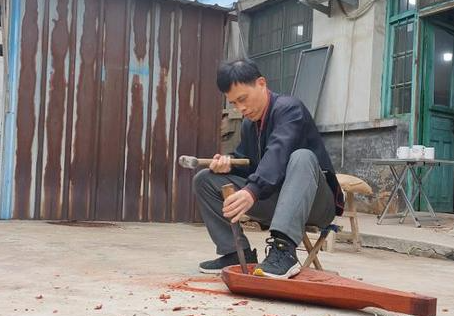Shandong handmade · Liaocheng courteous folk artists carry forward traditional culture
Inherit the craft and keep the memory. "If you want to do good work, you must first sharpen your tools." There is a pipa with elegant appearance and good sound, which is the pursuit and hope of those who practice pipa playing or perform on stage.
In Gaoji Town, Dong'e County, Liaocheng City, Shandong Province, there is a "pipa" artist named Zhao Yanfu. He has been obsessed with making piano for 25 years. It is not an exaggeration to say that he is "hidden in the mountains", because in his words "some young people in the village I didn't know I could still do pipa."
In 1997, Zhao Yanfu went to Beijing to work for a living. By chance, he met a pipa craftsman. At that time, he learned to make pipa while working part-time, starting from the most basic woodworking skills such as sawing and planing wood, and slowly growing from an apprentice to a folk artist. He was not afraid of hardships, and accumulated little by little , With enthusiasm, this study is 13 years.

"At that time, we were only in our early 20s. When we first came into contact, we didn't understand anything, and we knew nothing about the highly specialized process of tuning." Recalling the days when he lived in Beijing when he was young, Zhao Yanfu had a smile on his face, he admitted frankly. , When I saw a complete pipa made, I felt quite proud.
At the beginning of 2010, Zhao Yanfu took this craft back to his hometown and into the fields, working as both an artist and a farmer. Today, the pipa he makes are loved by many professionals, and nearly 60 works are sold to Xiamen, Guangzhou, Ningbo and other places every year.
In the studio of more than 40 square meters built by Zhao Yanfu, the reporter noticed that all kinds of tools for making pipa are readily available, and most of them are hand-made by Zhao Yanfu. "When making a pipa, you must endure loneliness, and you can't rush for success. The production process is also a process of tempering your physical and mental character. It usually takes five years to produce a good work." Zhao Yanfu said, from material selection, rough production, natural air drying, and fine backing. From production to fine grinding, tuning, polishing, and waxing, as an ancient national musical instrument, the production of pipa has to go through more than 100 processes, large and small.
The selection of materials for pipa is particularly important. "The harder the wood, the better the sound quality," Zhao Yanfu said. In order to ensure the quality, he will choose wood with a higher density, old paulownia and old southern bamboo as raw materials. The material of the back panel of the pipa will affect the timbre. Most of the back panels are made of safflower pear, red rosewood and red sandalwood.

When assembling, it is necessary to glue the back plate and the paulownia board together, and then glue the prepared headstock, top plate, piano shaft, Yamaguchi, 6-phase, 24-fret, hand, phoenix stage, strings, head flower and other components in turn. At each position on the back plate, it is then hand-polished with sandpaper of different thicknesses, and polished with beeswax to create the finished pipa.
Now, after years of exploration, Zhao Yanfu is constantly improving and innovating the pipa production process. "Pipa making is an old craft, and the next step is to make it bigger, stronger and better, pass on this skill well, and be a disseminator of excellent traditional culture." Zhao Yanfu said.
 渝公网安备 50010702504639号
渝公网安备 50010702504639号